|
 Back to index Back to index
|
| Itineraries > The Montes de Hierro Greenway |
| The Montes de Hierro Greenway |
|
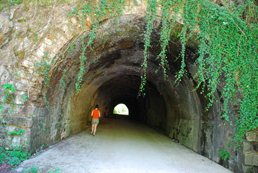
|
The new Montes de Hierro Greenways network is a journey through the underground history of Vizcaya. Because for centuries iron moulded the landscape, the life, and the character of this region, before the alchemy of the Guggenheim museum clad it in shining titanium.
This Greenway network is a must for anyone wishing to discover the roots of our cosmopolitan 21st century Greater Bilbao by following the path of these iron arteries which in bygone days forged the city and its surroundings.
These trails whisper to their travellers a mute testimony from centuries gone by, relating legends from the Roman Empire to the Industrial Revolution and revealing like an open book all the secrets of the men and women of iron who were behind them.
|
| WRITE YOUR REVIEW
|
| Technical Data
|
|
 CONDITIONED GREENWAY CONDITIONED GREENWAY
|
Exploring the mining landscape of Las Encartaciones/Enkarterri
LOCATION
Traslaviña (Artzentales) - Kobaron (Muskiz)
BIZCAIA
Length: 42,5 Km
Users:     *
(*) Km 8: In the area of the Sopuerta quarry there is a short section with a significant slope *
(*) Km 8: In the area of the Sopuerta quarry there is a short section with a significant slope
(*) Km 16: At the recreational area of La Aceña there is a steep incline and the temporary closure of a tunnel obliges users to take a provisional detour along a dirt track
|
|
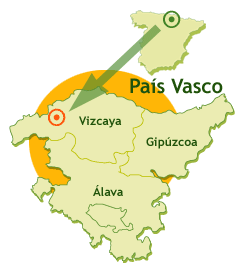 |
(*) Km 39: On arriving at Playa de La Arena beach it is necessary to cross a short stretch of sand. For cyclists, skaters, those with baby buggies, and persons of restricted mobility, access to the section of the Itsaslur Greenway should be made via the village of Kobaron since the access via Pobeña requires negotiating a steep flight of steps
These latter obstacles are expected to be removed in the medium term thanks to an inter-territorial initiative affecting the costal path between Muskiz and Mioño (Cantabria) under the auspices of the Ministry of the Environment, Rural and Marine Affairs
 : Section of bidegorri or cycle path between Gallarta – Playa de La Arena and the Pobeña – Kobaron section of the Itsaslur Greenway : Section of bidegorri or cycle path between Gallarta – Playa de La Arena and the Pobeña – Kobaron section of the Itsaslur Greenway
Type of surface:
Compacted gravel between the FEVE station at Traslaviña (Km 0) and Santelices (Muskiz) (Km 25). Tarmac between Santelices (Km 25) and Kobaron (Muskiz) (Km 42.5)
Natural settings:
Mercadillo or Barbadun Valley. Salt marshes of the river Barbadun and Playa de La Arena in Muskiz. Regeneration forests. Views over the sea and of beautiful valleys covered with either Atlantic forest or plantations of pine and eucalyptus
Cultural heritage:
The route is dotted with a great many mining remains: mining sites, mines, loading yards, etc. At Sopuerta you can visit the Las Encartaciones Museum (Barrio Abellaneda), the old mining town of Alen, and the ore calcining kilns at Barrio El Alisal.
At Galdames there is the Loizaga Tower with its impressive collection of Rolls Royces and, on the way towards Muskiz, we come across the remains of ironworks on the banks of the river Barbadún, along which runs the Ruta de las Ferrerías (Ironworks Route). Here there is the largest collection of protoindustrial ruins in Bizkaia, the most interesting of which is the El Pobal ironworks which you can visit. In Muskiz there is also the Castillo de Muñatones; visits to the castle can be arranged at the El Pobal ironworks.
At Abanto-Zierbena we can visit the Basque Mining Museum, the calcination kilns of the San José and Lorenza mines, the limestone needles of the Cristina mine, and the pithead frame of the Ezequiela mineshaft.
UNESCO Heritage in the surroundings of the Greenway. #Greenways Heritage 
Vizcaya Bridge (in Getxo) and Routes of Santiago de Compostela: Camino Francés and Routes of Northern Spain (coincident with Paseo Itsaslur Greenway More info>>
Infraestructure:
Greenway (Traslaviña – Gallarta, and Pobeña-Kobaron) and bidegorri/cycle path (Gallarta – Playa de La Arena). 7 tunnels (3 with lighting), 7 buildings linked to mining operations (3 in ruins), 7 rest areas, 11 recreational areas, 1 play area in the recreational area of La Aceña, water fountains, benches, waste bins, and signage. The Santelices-Gallarta section is illuminated by lampposts
Recreational areas of Tuetxe, Santa Cruz and La Toba in Artzentales; Alén, San Roque de Carral, El Alisal and La Baluga in Sopuerta; La Aceña/Atxuriaga and Aguasjuntas in Galdames; Siete Robles and El Cerrillo in Abanto-Zierbena; and Rebortun in Muskiz
How to get there:
Feve. Bilbao – Santander Line. Traslaviña Station (Artzentales)
Metro Bilbao. Sestao Station. Line 2
Railway. Suburban network. Line C 1. Bilbao-Santurtzi: Sestao and Portugalete stations. Line C 2. Bilbao-Muskiz: Urioste (Ortuella), Gallarta (Abanto-Zierbena), Putxeta (Abanto-Zierbena) and Muskiz
Galdames stations: Bus Empresa Encartaciones (Bizkaibus). Lines A3323, A3334, A3336 and A3337
Artzentales: Bus (Bizkaibus). Line A0652
Connections:
Bilbao: 20 km to Gallarta
Maps to use:
National Geographic Institute Map:scale 1:25.000. Sheet 61-I
Ministry of Development Official Road Map.
Further information in the Greenways Guide, volume III
|
|
|
|
| Description
|
Section II. Cycle path / bidegorri: from Gallarta to the Itsaslur Greenway
Km. 31
Section III. Itsaslur Greenway. From Pobeña to Kobaron
Km. 39 / Km. 42,5
|
|
Introduction
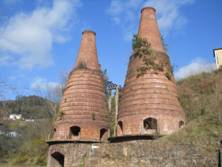 The original purpose of the network of Montes de Hierro Greenways was to join the two existing Greenways in the rural district of Las Encartaciones/Enkarterri, on the left bank of the Bilbao estuary: the Itsaslur Greenway and the Galdamesa Greenway. In 2011 the latter extended its route by 15 km to reach the FEVE station at Traslaviña, following the path of the old Castro-Traslaviña railway line. For 2012 a further extension of the route is planned in the direction of the Bilbao estuary: Sestao, Portugalete and Barakaldo. The original purpose of the network of Montes de Hierro Greenways was to join the two existing Greenways in the rural district of Las Encartaciones/Enkarterri, on the left bank of the Bilbao estuary: the Itsaslur Greenway and the Galdamesa Greenway. In 2011 the latter extended its route by 15 km to reach the FEVE station at Traslaviña, following the path of the old Castro-Traslaviña railway line. For 2012 a further extension of the route is planned in the direction of the Bilbao estuary: Sestao, Portugalete and Barakaldo.
All the railway routes share a common feature, their mining origins, linked to the extraction of high quality iron ore, which centuries ago was renowned throughout Europe, even getting a mention in the works of Shakespeare. And in the more recent past, iron drove the industrial development of the entire Greater Bilbao area (with companies such as Altos Hornos de Vizcaya), giving rise both to the birth of the Basque bourgeoisie and of the labour movement and its most emblematic leaders.
The existence of the Montes de Hierro Greenways network is thanks to the efforts and collaboration of many nameless people, public institutions and small local associations: the Ministry of the Environment and Rural and Marine Affairs, the Spanish Railways Foundation, FEVE, the Basque Government, the Regional Government of Vizcaya, Basquetour, ADR Enkarterrialde, Enkartur, the Mancomunidad (Commonwealth) de Las Encartaciones, several town councils (Abanto-Zierbena, Arzentales, Barakaldo, Galdames, Muskiz, Portugalete, Sopuerta, Sestao, Zierbena…) and many more besides, all of which have enthusiastically taken part in this joint project for more than 10 years.
We invite you to start the Montes de Hierro Greenways from km 0, at Traslaviña train station. Or from wherever you prefer. Design the route of your choice as from July 2011 on the web page at: www.montesdhierro.com.
|
Access through Google Earth to view the entire route in Street View Google Maps.
More than 70,000 spherical photographs and many points of interest make up this great 360º virtual tour through the Greenways of Montes de Hierro and Paseo de Itsaslur.
¡Do not miss it!
Access Google Earth >>
|
Section I. Alimoche Greenway - Galdames: From Traslaviña to Gallarta
Km 0
The Montes de Hierro Greenways set off from the Traslaviña train station on the present Bilbao–Santander FEVE line. From here we can also access the Ironworks Route and the GR-281 footpath (which takes us through Balmaseda to the heights which border on the river Kadagua). There is an active service point, at 0 km, Burdinkleta.
If we take the Greenway, we will arrive at Las Barrietas by following the crystalline waters of the river Kolitza, through two tunnels (87 and 147 metres in length, respectively), an old iron mill and a pretty wooden footbridge crossing the river.
Km 4
On the far bank we are greeted by the ruins of another iron mill and of an old mineral ore loader next to the old train station. At this point the junction with the road leading up to the former mining village of Alén invites us to make a detour from the Greenway to discover mountain bloomeries (ironworks) dating back to over 2,000 years ago, in a zone now equipped as a recreational area.
Km 10
If we continue along the Greenway flanked by forest on either side, in a short while we will be able to see the spectacular crags which are home to the Egyptian vulture, an unusual bird in danger of extinction. Then, after travelling across the top of the Sopuerta quarry, we arrive at the village of El Castaño, where we are greeted by an old railway wagon inviting us to visit the Catalina mine complex, famous for its two calcining kilns and the Los Herreros tunnel, a 2 km long bore which was excavated by pick and shovel in the first half of the 20th century. The El Alisal recreational area is also nearby.
The tunnel, an impressive feat of engineering, allows the railway to pass under the Muñecas Pass and reappear in the Cantabrian Otañes valley, before finally arriving at the site of the once magnificent cantilever loading arm which used to overhang the cliffs at Castro-Urdiales before it was swept away in a gale. The long-awaited refurbishment of this tunnel may one day enable the route of the Greenway to reach the original destination of the Traslaviña – Castro railway; the sea.
Km 12
After passing through another tunnel and leaving behind the Ermita del Pilar chapel we reach Sopuerta Abentura, an attractive family adventure park offering a variety of activities (see www.sopuerta-abentura.com).
Km 14
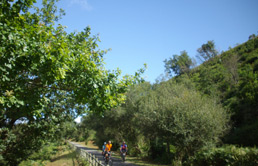 Pressing on beyond the Jarralta dam loading facility we arrive at El Arenao (where we rejoin the Ironworks Route), before reaching the old railway bridge, now refurbished as a majestic wooden footbridge over the road. A little further on, another wooden footbridge over the river Barbadun (teeming with trout and also salmon to an increasingly greater extent) and a short tunnel under the road lead us through a wetland area to La Aceña, where the former Sestao-Galdames and Castro-Traslaviña railways used to meet. Pressing on beyond the Jarralta dam loading facility we arrive at El Arenao (where we rejoin the Ironworks Route), before reaching the old railway bridge, now refurbished as a majestic wooden footbridge over the road. A little further on, another wooden footbridge over the river Barbadun (teeming with trout and also salmon to an increasingly greater extent) and a short tunnel under the road lead us through a wetland area to La Aceña, where the former Sestao-Galdames and Castro-Traslaviña railways used to meet.
Km 16
In order to reach La Aceña we need to climb a steep slope, although we can the regain our strength by taking a rest at its recreational area, with picnic tables, a kiddies’ playground, and a beautiful riverside walk around the Tardía and Berango mines. This is the site of an old mining village which today is occupied by a pleasant reservoir, now used as a trout fishing reserve. In the vicinity there is a bar-restaurant, accommodation, and a sport area with a car park which once again connects us with the GR-281 footpath. There is a plan to set up a bike rental point at the old railway station. There is an active service point at 16 km, Kirik. In addition, at km 16, there is an educational area called Parque Infantil de la Naturaleza (PIN) (Nature Playground).
If we continue along the Greenway through a series of tunnels, such as the Vallejas tunnel and the Malpeña tunnel (also known as the “Witch’s Tunnel”) and one or two more, we pass through the Galdames valley to the Mercadillo valley through a succession of shades of green, which is a constant companion on our journey, until we arrive at the village of El Cerco. Here there used to be another ore train loading facility, of which little survives; only strange embankments and walls forming a railway cutting, and, to our right, a circular depression which used to house a railway turntable for the locomotives needing to turn around at this point.
Km 23
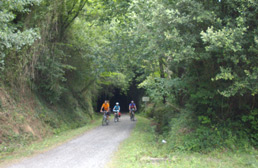 Continuing through the tree covered landscape, a constant of this section, we arrive at Santelices, where a crossroads offers us the possibility of leaving the Greenway, either to drop down to the El Pobal ironworks or to climb up to the Peñas Negras Mining Interpretation Centre and the mining village of La Arboleda. This latter detour takes us high into the Montes de Triano hills and affords us a view of a spectacular landscape where we can see a large number of abandoned mining operations and the way they have been integrated into the landscape, often in the form of reservoirs and lakes. Nevertheless, it is worth carrying on along the Greenway another 8 km further to the village of Gallarta. Continuing through the tree covered landscape, a constant of this section, we arrive at Santelices, where a crossroads offers us the possibility of leaving the Greenway, either to drop down to the El Pobal ironworks or to climb up to the Peñas Negras Mining Interpretation Centre and the mining village of La Arboleda. This latter detour takes us high into the Montes de Triano hills and affords us a view of a spectacular landscape where we can see a large number of abandoned mining operations and the way they have been integrated into the landscape, often in the form of reservoirs and lakes. Nevertheless, it is worth carrying on along the Greenway another 8 km further to the village of Gallarta.
Km 27
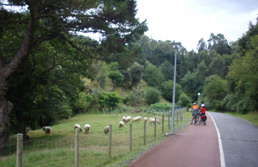 In Gallarta the Basque Mining Museum awaits us with its spectacular views over the Concha Mine which, having been excavated under the original village for decades, now has galleries which are below sea level. In Gallarta the Basque Mining Museum awaits us with its spectacular views over the Concha Mine which, having been excavated under the original village for decades, now has galleries which are below sea level.
As we continue along the route, punctuated by magnificent views of the village of Putxeta, the Pozo Gerente reservoir, and Playa de La Arena beach, we come across the Borja Mine loader, the El Sobaco tunnel (a 150 metre long tunnel which is disproportionately wide for a narrow gauge railway, equipped with excellent lighting and with a pavement for pedestrians), and the Cotorrio hostel. And further on still we reach the ruins of the El Once loading facility (so called because it is eleven kilometres from the start of the Sestao-Galdames railway line, ‘once’ being the Spanish for ‘eleven’), where we find the end of a long inclined plane, the largest in the area, which used to serve the Saúco Mines at Galdames.
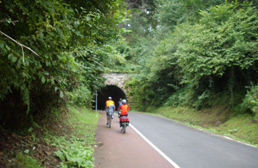
After the Picón bend a recreational area invites us to take a break next to the old Los Castaños station. The depression which used to house the turntable where the small locomotives used to turn around still exists today, now converted into a neat little pond.
If we continue along the Greenway, the old San Fermín inclined plane and the Calcos Viejos tunnel (50 m long) lead us towards an urban section where the Greenway runs parallel to the motor traffic, so we will need to take extra care here. After leaving the village, home to the former Hospital Minero de Triano (Triano Mining Hospital), the Mining Museum and the Concha Mine, we rejoin a quieter section, where the Greenway splits in two. One fork takes us to the sea and the other to the Bilbao estuary.
Section II. Cycle path / bidegorri: from Gallarta to the Itsaslur Greenway
Km 31
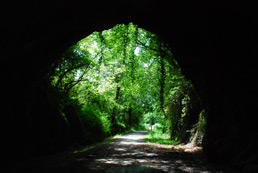 Until the imminent refurbishment of the Benedicta tunnel in Sestao restores the original route of the iron ore to the Bilbao estuary where shortly the Greenway will link up with the cycle path (bidegorri) network of Greater Bilbao, we recommend the following route to the sea. We will need to take the bidegorri to our left next to the recreational area which has been set up next to Gallarta’s football ground, following the spectacular bucket line of the Orconera Iron Company, for the barely 8 km stretch separating us from the Cantabrian Sea, the Playa de la Arena beach, and the cliff top Itsaslur Greenway. Until the imminent refurbishment of the Benedicta tunnel in Sestao restores the original route of the iron ore to the Bilbao estuary where shortly the Greenway will link up with the cycle path (bidegorri) network of Greater Bilbao, we recommend the following route to the sea. We will need to take the bidegorri to our left next to the recreational area which has been set up next to Gallarta’s football ground, following the spectacular bucket line of the Orconera Iron Company, for the barely 8 km stretch separating us from the Cantabrian Sea, the Playa de la Arena beach, and the cliff top Itsaslur Greenway.
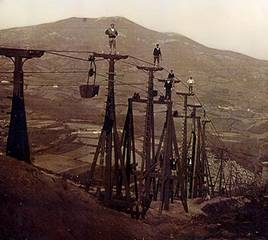
At this point it is worth mentioning the Orconera Iron Company’s aerial bucket tramway. This tramway, which used to link the Carmen VII mine in Ortuella with the ore washing facility at Pobeña in Muskiz, could be considered to be the last link in the Montes de Hierro Greenways network.
While the original route is impossible to restore (since it was an aerial transport system), the remains of this great engineering feat –considered in its day to be the most important in Europe due to its technical perfection and its length (8 km)-, has spawned another traffic free route in the form of the bidegorri or cycle path which runs between Abanto-Zierbena and Muskiz.
Section III. Itsaslur Greenway. From Pobeña to Kobaron
Km 39
Once we set foot on the ferrous red beach at Playa de La Arena, it is worth stopping to take a stroll around the dunes and salt marshes, home to such beautiful birds as the heron and such strange birds as the cormorant, before finishing off our journey by accessing the Itsaslur Greenway via a short flight of steps at Pobeña on the far side of the bridge which spans the Barbadun river. Here we can still find traces of the old bucket line, and we link up with another important cultural asset, the Way of St James, and a hostel for pilgrims of that route.
Km 42,5
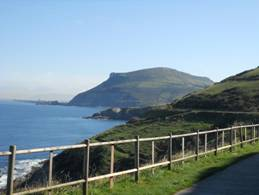 After taking the opportunity to admire the unique mining heritage site of the El Castillo, Josefa and Amalia Vizcaína coastal mines, where a few years ago the sea swept away the only Vizcayan loading facility capable of loading ships on the open sea, we reach our final destination. Later we can enjoy a well-earned rest at the recreational area which signals the end of our marathon journey. Although… after having a rest, those who are eager for more can follow the path on to the Piquillo Greenway, which takes us to the beautiful seaside town and fishing port of Castro Urdiales and the province of Cantabria. After taking the opportunity to admire the unique mining heritage site of the El Castillo, Josefa and Amalia Vizcaína coastal mines, where a few years ago the sea swept away the only Vizcayan loading facility capable of loading ships on the open sea, we reach our final destination. Later we can enjoy a well-earned rest at the recreational area which signals the end of our marathon journey. Although… after having a rest, those who are eager for more can follow the path on to the Piquillo Greenway, which takes us to the beautiful seaside town and fishing port of Castro Urdiales and the province of Cantabria.
Further information about the Paseo Itsaslur Greenway.
|
|
|
|
|
|
|
|
| Railway History
|
|
Línea Castro – Traslaviña. Este, era también un ferrocarril minero. Fue en 1914 cuando se estableció la compañía concesionaria: Ferrocarril de San Julián de Musques a Castro Urdiales y Traslaviña. Nació con la pretensión de unir el ferrocarril de Triano con el Santander-Bilbao. Su actividad fue la del transporte de mercancías, siendo a partir de 1922 explotado por los Ferrocarriles del Estado. En 1966 fue cerrado debido a la baja rentabilidad, provocada en buena parte por la crisis minera. Desde hace unos años se trabaja tanto en parte vasca como en el municipio cántabro de Castro Urdiales por hacer posible su recuperación como vía verde.
Línea Sestao – Galdames. Fue allá por el año 1876 cuando los empresarios ingleses de la Bilbao River Cantabrian Rail inauguraron un ferrocarril de 22 km queunía sus explotaciones mineras del municipio de Galdames con losmuelles del Nervión en Sestao. Fue el más largo y el único de losferrocarriles mineros de esta zona que comunicaba el Nervión conla cara occidental de los montes de Triano.
Su sinuosísimo trazado contó con un ancho peculiar (1,14 m) y por sus raíles, además de transportarse la producción de sus propias minas en Galdames, se movieron los minerales de todas las minas vecinas al ferrocarril. Así, numerosos cargaderos jalonaban esta ruta. El más singular de ellos se situaba en el barrio de La Florida. A este punto arribaba un excepcional plano inclinado de casi 4 Km. de longitud que, desde la Mina Sauco, llegaba al ferrocarril. Fue uno de los planos más largos de España y contaba con seis estaciones intermedias para el trasiego de sus vagonetas.
Además de transportar mineral al puerto y a las acerías bilbaínas, sus carriles soportaron un tráfico, más o menos regular, de trenes de viajeros. Estos pasajeros no eran otros que mineros que, aprovechando la facilidad de transporte ofrecida por este ferrocarril, fueron asentándose en sus márgenes, creando nuevos barrios mineros en plena montaña: La Balastrera, La Aceña, Saúco... Tras la Guerra Civil fue otra empresa con nombre anglosajón la que adquirió el trazado ferroviario, la Babock & Wilcox, entidad que gestionó la explotación hasta el año 1968. Cuatro años más tarde, en 1972, las vías fueron desmanteladas y su camino quedó expedito para nuevos usos.
El ferrocarril de Covarón. Hacia 1860 la sociedad The Vizcaya and Santander Mining Cº Ltd inicia la explotación de las minas San Julián y Amalia Vizcaína en el barrio de Kobaron (Muskiz. Bizkaia). Pero es la compañía del ingeniero escocés José Mac Lennan quien una década más tarde impulsa la explotación y comercialización industrial del mineral. Para dar salida a la producción de rubios y carbonato de hierro la compañía Mac Lennan construye un ferrocarril de ancho métrico y 2,6 km de longitud, entre el paraje de El Covarón y el cargadero costero de Campomar, donde embarcaba en dirección a Durham (Inglaterra). El primigenio sistema a sangre es sustituido por locomotoras de vapor en 1895, cuyos talleres y depósitos se situaron en la misma estación de El Cobarón.
Más adelante la línea principal se alargaría con un segundo e inconexo tramo ferroviario de 500 mm de anchura. El conoció como Ferrocarril del Carrascal arrastraban el mineral de las minas San Francisco y Consolación, en la zona de el Carrascal, hasta la estación de El Cobarón, donde trasvasaba el mineral, mediante dos planos inclinados de 20 metros, en el ferrocarril de Compomar. En el año 1963 cesa toda actividad minera y el cargadero embarcaba su última remesa.
|
|
|
| Interesting Data
|
|
|
|
|
|
|
|
|
|
|
|
|
1. Festivals and holidays |
|
|
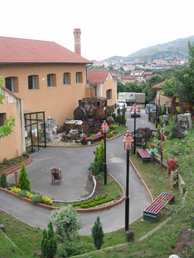
|
|
|
|
|
2. Accommodation |
|
|
|
|
|
|
3. Eco-tourism |
|
|
|
|
|
|
4. Managing Authority |
|
|
|
|
|
|
5. Town Councils |
|
|
|
|
|
|
6. Emergencies |
|
|
|
|
|
|
7. Coaches & buses |
|
|
|
|
|
|
8. Railway |
|
|
|
|
|
|
|
Festivals and holidays
|
 return return |
|
|
|
|
|
|
|
Artzentales
September 2
San Antolín
September 8
Nuestra Señora de Traslaviña
September 14
Exaltación de Santa Cruz
September 29
Festividad de San Miguel
Sopuerta
June 24
San Bartolomé
July 26
Santa Ana
August 16
San Roque
Galdames
June 29
San Pedro |
|
June 30
Santa Lucía
December 24
Ogi Eguna
Muskiz
June 24
San Juan
Third Sunday of September
Feria agrícola y ganadera
Fourth Saturday in September
Feria de caza y pesca
Abanto-Ciérvana/Abanto-Zierbena
June 13
San Antonio de Padua
June 29
San Pedro
June 30
Santa Lucía
Ortuella
May 18,
San Félix de Cantalicio |
|
|
|
|
|
|
|
|
|
|
|
|
Accommodation
|
 return return |
|
|
|
|
|
|
|
|
|
Apartamentos La Arema
Playa de La Arena. Ziérbena
Telf. 946 365 454
Hotel Kaia
Bº El Puerto, 19
Zierbena
Tfno. 946 366 374
Abanto-Zierbena
Casa rural San Pedro
Telf. 946 368 766
www.arsanpedro.com
Albergue Municipal
(Barrio de Cotorrio)
Telf. 94 636 20 00
Ortuella
Hotel Ortuella**
Telf. 94 635 32 04
www.hotelortuella.com
Albergue del Camino de Santiago
Tel. 946 802 976. Open from May to september.
|
|
|
|
|
|
|
|
|
|
|
|
|
Eco-tourism
|
 return return |
|
|
|
|
|
|
|
Tourism Encartaciones. Enkartur- Tourism Office Tel.946 802 976
Sopuerta Tourism Office Tel.94 610 40 28
Burdinkleta. Traslaviña ancient station.
Artzentales. Guide tours, renting bikes y adapted cycling.
Tel. 669 330 277; 636 374 520
Environmental Interpretation Center of Peñas Negras (Ortuella)
Surf School-Center La Arena (Zierberna)
Playa La Arena Telf. 636 921 673
Erauntsi Surf Taldea. Surf. Playa de La Arena (Zierbena). Tel. 658 755 472
Areitz Soroa School of Environmental Education (Galdames) Tel. 94 650 41 54
Torre Loizaga (Galdames). Rolls-Royce museum
Telf. 946 802 976 www.torreloizaga.com ; info@torreloizaga.com
Mining Museum in the Basque Country (Gallarta).
Encartaciones Museum. (Sopuerta) Tel. 946 504 488 / 946 104 815;
Castillo de Muñatones
Bº San Martin (Muskiz)
Telf. 629 271 516
Sopuerta Aventure (Sopuerta).
Park Adventure on the trees
Tel. 637 443 074
Ferreria El Pobal. Ctra. Muskiz-Sopuerta Tel: 629 271 516
|
|
|
|
|
|
|
|
|
|
|
|
|
Managing Authority
|
 return return |
|
|
|
|
|
|
|
|
Encartaciones Tourism “ENKARTUR”
C/ Martin Mendia, 2
48800 Balmaseda
|
|
|
|
|
|
|
|
|
|
|
|
|
|
Town Councils
|
 return return |
|
|
|
|
|
|
|
|
|
Muskiz
Telf. 946 706 000
www.muskiz.org
Abanto-Ciérvana/Abanto-Zierbena
Telf. 946 362 000
www.abanto-zierbena.org
Ortuella
Telf. 946 640 200
www.ortuella.biz |
|
|
|
|
|
|
|
|
|
|
|
|
Emergencies
|
 return return |
|
|
|
|
|
|
|
EMERGENCIES: Tel. 112
|
|
|
|
|
|
|
|
|
|
|
|
|
Coaches & buses
|
 return return |
|
|
|
|
|
|
|
|
|
|
|
|
|
|
|
|
|
|
|
|
Railway
|
 return return |
|
|
|
|
|
|
|
Renfe. Telf. 902 240 202. www.renfe.es
Feve. Telf. 944 250 615; www.feve.es |
|
|
|
|
|
|
|
|
|
|
|
|
|
| Links
|
|
Official Website Tourism of the Basque Government.
Official Website of Euskadi MTB Centres
Official site for hiking in Euskadi
Website of the Provincial Council of Bizkaia
Tourism page Bizkaia Provincial Council.
Tourism resources page of the region of the Encartaciones
Accommodation rural tourism
|
|
|
| Digital Montes de Hierro Greenway
|
|
|
Digital Montes de Hierro Greenway is a comprehensive digitization project of the Montes de Hierro Greenway and the Paseo Itsaslur Greenway (Bizkaia).
42.5 km in 360º and more than 70,000 photographs to travel and know the itinerary through Google Maps Street View.
With the collaboration of Enkarterrialde, Rural Association of Las Encartaciones and the Greenway area of the Spanish Railway Foundation.
|
|
|
|
|
|
|
|
|
